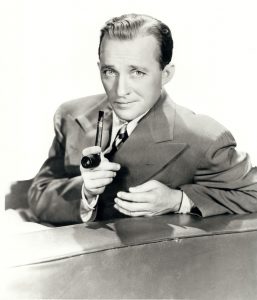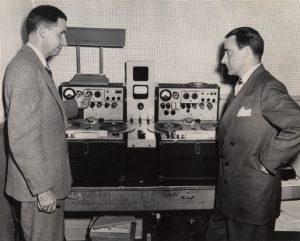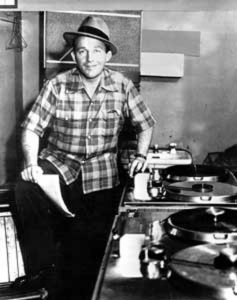
We mark the death on October 14, 1977 – 42 years ago today – of the American singer and actor Harry Lillis “Bing” Crosby of a so-called “widow maker”: a massive, dead-before-he-hit-the-ground heart attack. We sense that he went out the way he would have chosen to go out. An avid golfer and member of the World Golf Hall of Fame, he flew to Spain on October 13, 1977 to hunt partridge and play golf. The next day, on October 14, having finished an 18-hole round at the La Moraleja Golf Course near Madrid, Crosby and his golfing partners were walking back the clubhouse. Crosby then uttered his last works, “That was a great game of golf, fellas. Let’s get a Coke.” Moments later, at about 6:30 pm, about 20 yards from the clubhouse, Crosby dropped dead.
(As last words go, well, had Crosby the opportunity, he probably would have taken a Mulligan on “let’s get a Coke.” We would recall the last words of his friend, performing partner, and golfing chum Bob Hope, who when asked where he wanted to be buried, replied “surprise me.”)
Anyway, Crosby went out with his cleats on.
Rarely would it seem that someone’s public persona was so different from his private persona. On stage, Crosby’s chocolaty bass-baritone voice virtually defined the sobriquet “crooner”. His on-screen persona was that of a pipe-smoking, smooth-as-a-peeled-onion gentleman: preternaturally calm, wise, and loving: everyone’s favorite uncle or priest (that would be Father O’Malley in the movie Going My Way of 1944).
In reality, Crosby was a sharp, calculating, entrepreneurial, sometimes ruthless perfectionist and businessman with a propensity for drink. He was also a harsh disciplinarian whose four sons from his first marriage (he was to have three more children from his second marriage) not-infrequently felt the bite of a special, metal-studded belt with which Crosby beat them.
(After Crosby died, his son Gary – the eldest – wrote a tell-all memoir called Going My Own Way, in which he depicted his father as “cruel, cold, remote, and physically and psychologically abusive.” Gary Crosby wrote:

“When I saw Going My Way I was as moved as they [the audience] were by the character he played. Then the lights came on and the movie was over. All the way back to the house I thought about the difference between the person up there on the screen and the one I knew at home.”
Bing Crosby’s son Phillip took his brother Gary to task for his description of their father, claiming that:
“Gary is a whining, bitching crybaby, walking around with a two-by-four on his shoulder and just daring people to nudge it off. . . My dad was not the monster my lying brother said he was.”
However, Bing’s other two sons by his first marriage – Dennis and Lindsay Crosby – confirmed that Crosby was indeed abusive. In reference to his brother Gary’s tell-all, Lindsay Crosby said:
“I’m glad [Gary] did it. I hope it clears up a lot of old lies and rumors.”
Crosby’s treatment of his first-born sons after his death cannot be disputed. His will created a blind trust that stipulated his sons only receive their inheritance when they reached the age of 65. Only one of the four boys lived so long. Lindsay Crosby died in 1989 at the age of 51 of a self-inflicted gunshot. Dennis Crosby died in 1991 at the age of 56 of a self-inflicted gunshot. Gary Crosby died in 1995 at 62 of lung cancer. Only Phillip Crosby lived to see his inheritance; he died in 2004 at the age of 69 of a heart attack.
Two suicides out of the four sons from Bing Crosby’s first marriage. It sounds as if something was seriously amiss in the Crosby house.)
Having gotten the controversial stuff out of the way, it is time, now, to praise Crosby for the far-sighted, entrepreneur and techno-prophet that he was: someone who single-handedly revolutionized the radio and nascent television industries!
During the so-called “golden age of radio” – from roughly 1930 to 1950 – almost all radio shows were broadcast live. This necessitated that performers like Bing Crosby had to do the same show twice in one day: once for East Coast audiences and then, three hours later, for broadcast to West Coast audiences.
By 1945, Der Bingle had had enough of the two-shows-a-day regimen. There was a technology available for pre-recording shows, which involved cutting 16-inch records (which were also called “lacquer discs” or “shellacs”) that held ten minutes of programming per side when played at 33 1/3 rpm.
But NBC, which broadcast Crosby’s show, would not hear of recording it. John Dunning, writing in his book On the Air: The Encyclopedia of Old-Time Radio, explains NBC’s attitude:
“[Crosby saw] an enormous advantage in prerecording his radio shows. The scheduling could now be done at the star’s convenience. But the networks and sponsors were adamantly opposed. The public wouldn’t stand for ‘canned’ radio, the networks argued. There was something magic for listeners in the fact that what they were hearing was being performed and heard everywhere, at that precise instant. Some of the best moments in comedy came when a line was blown and the star had to rely on wit to rescue a bad situation. Fred Allen, Jack Benny, Phil Harris, and also Crosby were masters at this, and the networks weren’t about to give it up easily.”
But the networks could not be collective pimples of the arse of progress forever, and it was Crosby who made the breakthrough.

We momentarily shift our attention to Germany, in early 1945. With World War Two drawing towards its conclusion, a Major in the United States Army Signal Corps named Jack Mullin was tasked with investigating German radio and electronic technology and experimentation. On a trip to Radio Frankfurt, Mullin encountered so-called Magnetophons – tape recorders – built by the German firm of AEG, their fidelity so great that “even those well acquainted with the industry could not tell the recordings from live play.” Mullin was floored: there was no such technology in the United States, and he had no idea such a machine even existed (he later joked that “the reason we didn’t know about the Magnetophon was that the Germans never bothered to classify it as top-secret.”)

Mullin managed to “acquire” (to the victors go the spoils . . .) two Magnetophons and 50 reels of oxide-coated PVC recording tape manufactured by BASF and brought them back to the United States. As German patents and copyrights registered during the war (1939-1945) were declared null and void after the war (to the victors. . .), Mullin was free to do whatever he wanted to do with his new toys.

Mullin modified the technology and demonstrated his new-and-improved tape recorders to the Institute of Radio Engineers in San Francisco on May 16, 1946. In June of 1947, while pitching his tape recorders to the Hollywood studios, Murdo MacKenzie of Bing Crosby Enterprises saw a demonstration. Crosby was immediately informed and the idea light over his head went into full shine. Here was the technology he had dreamt about: not only could he pre-record his shows and lose nothing in the fidelity of the playback, but he could edit those shows simply by cutting and splicing the tape!
Crosby wrote in his autobiography:
“By using tape, I could do a thirty-five or forty-minute show, then edit it down to the twenty-six or twenty-seven minutes the program ran. In that way, we could take out jokes, gags, or situations that didn’t play well and finish with only the prime meat of the show; the solid stuff that played big. We could also take out the songs that didn’t sound good. It gave us a chance to first try a recording of the songs in the afternoon without an audience, then another one in front of a studio audience. We’d dub the one that came off best into the final transcription. It gave us a chance to ad lib as much as we wanted, knowing that excess ad-libbing could be sliced from the final product. If I made a mistake in singing a song or in the script, I could have some fun with it, then retain any of the fun that sounded amusing.”
Crosby immediately hired the now-former Signal Corps Major Jack Mullin as his chief engineer, and together they recorded a “test” show using the German recording tape Mullin had “liberated” in 1945.
Working with Mullin, Crosby turned to what was then a six-person startup in San Carlos, California (just south of San Francisco). He invested $50,000 in the company and instructed it to perfect and manufacture the tape recorder. The company, created in 1944, was called “Ampex”, the name being based on that of its Russian-American founder, Alexander M. Poniatoff excellence.

The first tape recorder Ampex built was the Model 200, and the first two Model 200s were shipped in April of 1948. Those two machines – bearing the serial numbers “1” and “2” – were shipped to Bing Crosby Enterprises and were used to record Crosby’s show, now being broadcast on the newly founded American Broadcasting Company, ABC.
Because Bing Crosby, under the umbrella of “Bing Crosby Enterprises”, now produced, recorded and edited his own shows, he could determine what equipment he wanted to use and where he put the microphones. He no longer had to wear a toupee, as NBC had required he do for his live audience shows, and simply wore a hat instead. And he was able to record and incorporate into his show short advertisements for one of his latest ventures: the world’s first frozen orange juice, a product that was sold under the brand name “Minute Maid.”
In his memoir, written in 1976, Jack Mullin recalled how Crosby’s Ampex tape recorders were used to invent what became an enduring broadcasting technique:
“One time, Bob Burns, the hillbilly comic, was on the show, and he threw in a few of his folksy farm stories, which were not in the script. They got enormous laughs, which just went on and on. We couldn’t use the jokes, but [we saved] the laughs. A couple of weeks later he had a show that wasn’t very funny, [so] we put in the salvaged laughs. Thus the laugh-track was born.”
It is no exaggeration to say that Bing Crosby and the Ampex tape recorder revolutionized the radio and recording industries. The Crosby Research Foundation – yet another part of Bing Crosby’s media empire – held tape recording patents and developed equipment and recording techniques (such as the laugh-track) that are still in use today, 70+ years later.
But wait! There’s more!
Maestro Crosby wanted to be able to record and edit video with the same ease as audio. As such, he financed the development of videotape recording. On November 11, 1951, Bing Crosby Enterprises gave the world’s first demonstration of videotape recording in Los Angeles, using a modified Ampex 200 tape recorder and standard, quarter-inch tape moving at an astonishing 360 inches (30 feet!) per second.
We can only imagine what fun Bing Crosby would have had with digital.
For lots more on pretty much anything musical, go to my website and buy a course. Or buy two courses! Three courses! (That was my “Minute Maid” moment.) And make sure to subscribe on Patreon.
Listen on the Music History Monday Podcast
Podcast: Play in new window
Subscribe: Apple Podcasts | Spotify | Pandora | iHeartRadio | RSS | More
